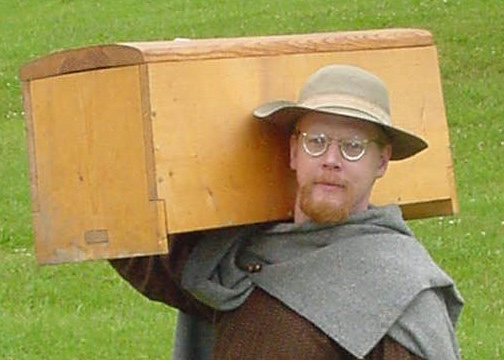The Mästermyr chest and ‘What did Vikings sit on?’
originally posted to the Norsefolk email list
While constructing a chest based on the Mästermyr find, I have noticed several odd features. The bottom fits into a dado on the ends, which extend downward to form the feet, and is also mortised into the ends, so weight on the bottom of the chest is transmitted to the ends (not odd).
- The chest is 90” long, but only 28” wide, so the bottom, only 3/4” thick, could use some support from the sides to enhance its rigidity. However, the sides have rabbets, which decrease the thickness of wood for the pegs which hold it together, and means the sides rest partly on the bottom.
- The sides are cut in such a way that they rest partly on the ends, which makes the chest more complicated and the tolerances much more finicky.
- The top is carved as a shallow barrel arch, which is more work than the whole rest of the chest and decreases the utility of the chest as a work surface and makes it harder to stack.

The one thing these three design points do enhance is the ability of the chest to carry weight on top of the lid, at some expense to the ability of the chest to carry weight inside. Also, the chest is long enough for two adults to sit on.
The majority of the half-dozen chests depicted in From Viking to Crusader are similarly long and narrow, with curved tops. I don’t know if they share the other design characteristics of the Mastermyr chest as well.
From this, I conclude that many, if not most, chests were designed to function well as seats. This may go some way toward explaining the paucity of chairs and stools discovered.
However, the Mästermyr chest has no carrying handles, making it inconvenient as a portable seat. Either
-
It was expected to be placed in a good place for a seat indoors, and something different was used outdoors and for any task where you needed to move your seat. Or,
-
It was not expected to be used as a portable seat very often.
Adding the info that there are lots of partial finds of stools, this suggests the following hierarchy of seating:
-
Built in benches and/or several chests as the fixed indoor seats; enough (or almost enough) for the usual residents of the farm.
-
Stools for moveable indoor seats and usual outdoor seats.
-
Chests as extra seating for guests at feasts, weddings, and all the other big gatherings that were a significant part of Norse culture.
This would avoid the needs for lots of stools, benches, or chairs which would only get used at feasts, and would need to be stored in-between times.
- Previous: Late Viking Age Ship Terminology
- Next: Knowledge & Handhelds